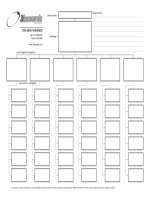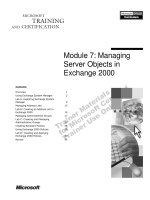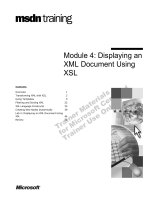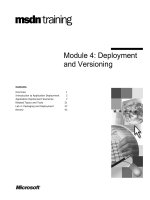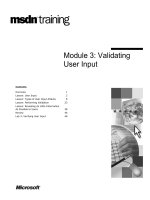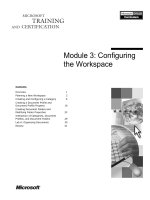Tài liệu Module 14: Site Server Integration doc
Bạn đang xem bản rút gọn của tài liệu. Xem và tải ngay bản đầy đủ của tài liệu tại đây (910.28 KB, 32 trang )
Contents
Overview 1
Expanding Search Options 2
Creating a Custom Search Solution 6
Building Search Pages 20
Review 26
Module 14: Site Server
Integration
Information in this document is subject to change without notice. The names of companies,
products, people, characters, and/or data mentioned herein are fictitious and are in no way intended
to represent any real individual, company, product, or event, unless otherwise noted. Complying
with all applicable copyright laws is the responsibility of the user. No part of this document may
be reproduced or transmitted in any form or by any means, electronic or mechanical, for any
purpose, without the express written permission of Microsoft Corporation. If, however, your only
means of access is electronic, permission to print one copy is hereby granted.
Microsoft may have patents, patent applications, trademarks, copyrights, or other intellectual
property rights covering subject matter in this document. Except as expressly provided in any
written license agreement from Microsoft, the furnishing of this document does not give you any
license to these patents, trademarks, copyrights, or other intellectual property.
1999 Microsoft Corporation. All rights reserved.
Microsoft, Active Desktop, Active Directory, ActiveX, BackOffice, Developer Studio, FrontPage,
JScript, MSDN, MSN, NetMeeting, Outlook, PivotChart, PivotTable, PowerPoint, Visual Basic,
Visual C++, Visual FoxPro, Visual InterDev, Visual J++, Visual SourceSafe, Visual Studio,
Windows, Windows Media, and Windows NT are either registered trademarks or trademarks of
Microsoft Corporation in the U.S.A. and/or other countries.
The names of companies, products, people, characters, and/or data mentioned herein are fictitious
and are in no way intended to represent any real individual, company, product, or event, unless
otherwise noted.
Other product and company names mentioned herein may be the trademarks of their respective
owners.
Project Advisor: Janet Wilson
Project Lead and Instructional Designer: Anne Bockman (Excell Data Corporation)
Instructional Designers: Josh Barnhill (Volt Technical) and Jo Berry (Exchange)
Lead Program Manager: Greg Bott
Program Managers: Colleena Carr and Chris Boar (Intl Vendor)
Graphic Artist: Andrea Heuston (Artitudes Layout and Design)
Editing Manager: Lynette Skinner
Editor: Jennifer Kerns (S&T Onsite)
Copy Editor: Shari G. Smith (R & S Consulting)
Online Program Manager: Arlo Emerson (Aditi)
Production Support: Irene Barnett (Barnett Communications)
Manufacturing Manager: Bo Galford
Manufacturing Support: Mimi Dukes (S&T Onsite)
Development Services: Kimber Dodge
Lead Product Manager: Mary Larson
Group Product Manager: Robert Stewart
Module 14: Site Server Integration iii
Instructor Notes Module 14: Site Server Integration
This module provides students with an understanding of the architecture and
capabilities of Microsoft
®
Site Server Search. At the end of this module,
students will be able to describe the purpose, components, and requirements of
Site Server Search; plan and create catalog definitions; and add search
functionality to a collaborative application.
Materials and Preparation
This section provides you with the materials and preparation needed to teach
this module.
Materials
To teach this module, you need the following materials:
Microsoft PowerPoint
®
file 1593a_14.ppt
Module 14, “Site Server Integration”
Preparation
To prepare for this module, you should:
Read all the materials for this module.
Read the instructor notes and margin notes for the module.
Presentation:
45 Minutes
iv Module 14: Site Server Integration
Module Strategy
Use the following strategy to present this module:
Expanding Search Options
Provide an overview of Microsoft Site Server and of search concepts.
Explain the architecture of Site Server Search.
Creating a Custom Search Solution
Explain how to plan a search system and describe the requirements for
crawling Microsoft Exchange Server public folders. Explain how to plan
catalog definitions and catalogs that include messages and database records.
Describe how to create and configure catalog definitions.
Building Search Pages
Explain how to use Query objects and how to collect search criteria from
users.
Module 14: Site Server Integration 1
Overview
Expanding Search Options
Creating a Custom Search Solution
Building Search Pages
At the end of this module, you will be able to:
Explain the purpose and architecture of Site Server Search, a component of
Microsoft
®
Site Server version 3.0.
Plan a search system that can crawl Microsoft Exchange Server public
folders. Plan, create, and configure a catalog definition.
Use script, the Query object, and Active Server Pages (ASP) to create a
search page that collects search criteria from users.
Slide Objective
To provide an overview of
the module topics and
objectives.
Lead-in
In this module, you will learn
about how to use Site
Server to define and build a
search catalogue that you
can access from within your
collaborative application.
2 Module 14: Site Server Integration
Expanding Search Options
Site Server Overview
Search Concepts Overview
Site Server Search Architecture
As the Internet and information technology have made it easier to generate and
store vast amounts of information, some organizations face the problem of
information overload. For example, in many corporations, workers can receive
information from such sources as Internet newsgroups, list servers, Web page
updates, and discussion groups. Although the availability of information and the
accumulated knowledge helps users make better decisions, it also forces them
to spend more time sifting through information to find the relevant bits and
pieces they need for their job. Users can spend less time sifting and more time
analyzing information if corporations enable them to search across multiple,
indexed data sources.
Microsoft Site Server and Microsoft Exchange Server can perform many
functions within an organization, including providing the infrastructure that
enables organizations to use collaborative applications that access a variety of
internal information sources:
Site Server provides features for full-text indexing, searching, and
delivering information.
Exchange Server provides the collaborative infrastructure and functionality
that enable you to create Internet newsgroups, threaded discussions,
customer contact databases, and custom collaborative applications.
Slide Objective
To outline this topic.
Lead-in
By incorporating Site Server
and Exchange Server, your
collaborative application can
access a variety of
information within an
organization.
Module 14: Site Server Integration 3
Site Server Overview
Collects and delivers
information from multiple
sources; also analyzes site
structure and site usage.
Enables site
administration team
to submit, approve,
and publish site
content.
Publishing
Publishing
Catalogs Web sites,
Exchange Server
folders, file servers, and
databases for
searching.
Search
Search
Delivery
Delivery
Site Server is a Web publishing, search, and delivery tool that works with
Microsoft Windows NT
®
Server and Microsoft Internet Information Server. It
enables you to build Web solutions that you can integrate into your
collaborative application.
Site Server Functions
The categories of Site Server functions include:
Publishing functions. Site Server includes tools that allow site
administrators—or designated users, such as content authors—to submit,
approve, and publish Web content.
Search functions. Site Server indexes documents that are located in file
systems, Web sites, Open Database Connectivity (ODBC) databases, and
mail servers, such as Exchange Server.
Delivery functions. Site Server collects information from multiple sources
and uses Hypertext Transfer Protocol (HTTP) to deliver information to Web
browsers. Site Server also enables site administrators to analyze the
structure and usage patterns of Web sites.
Site Server can also implement content tagging, a structured site vocabulary
that authors use to classify the content they create and specify key words for the
document. When used in conjunction with the knowledge-management
capabilities of Site Server, these tags enable users to find information easily.
Slide Objective
To describe the main
functions of Site Server.
Lead-in
Site Server includes
features that enable
publishing, searching, and
delivering information
through Web browsers.
4 Module 14: Site Server Integration
Search Concepts Overview
Views
Results
Crawls Web Sites,
File Systems,
Exchange Folders,
and Databases
Search Engine
Submits
Queries
Build Server
Build Server
Search Server
Search Server
Web Server
Web Server
User
User
Site Server version 3.0 includes a search component called Site Server Search
that provides site-administration tools for gathering and indexing information
and creating keyword-search capabilities on Web sites. These keyword-search
capabilities enable users to make highly specific queries to find and retrieve the
information they need.
The most efficient way to use Site Server Search is to build searchable
document catalogs, which are indexes that contain information about
documents, including key words and the location of each document. Catalogs
can index many types of documents, such as Microsoft Word documents,
e-mail messages, text files, Hypertext Markup Language (HTML) documents,
and Microsoft Excel spreadsheets.
With Site Server Search, you can build a catalog from documents found in
different places throughout a company’s file systems, Web servers, ODBC
databases, e-mail servers, and document management systems.
Slide Objective
To depict how Site Server
Search gathers information
from various sources and
makes it available to users
through a search server,
Web server, and browser.
Lead-in
You can use Site Server
Search to gather and index
information.
Module 14: Site Server Integration 5
Site Server Search Architecture
Crawls
Views
Results
HTTP Server
File System
Compiles
Catalog
Catalog
Submits
Queries
Propagates
Catalog
Definition
Catalog
User
User
1
1
1
2
2
2
3
3
3
ODBC
Database
Microsoft Exchange
Public Folder
Microsoft Exchange
Public Folder
Search Server
Search Server
Build Server
Build Server
Before learning about adding search functionality to a collaborative application,
you should understand how Site Server Search finds information in various
sources, indexes the information in catalogs, and searches those catalogs to
quickly find documents.
Finding, Indexing, and Searching Information
To locate information, Site Server Search performs the following functions:
Crawls. Site Server Search gathers content by using the build server to
perform a crawl (a methodical examination) of files located on the Web
servers, file systems, public folders, and ODBC databases that you specify.
Site Server Search creates a transaction log documenting all crawls.
As Site Server Search gathers content, it extracts either full text or attributes
from the documents it finds, depending on your choice. Attributes of
documents can include author, key words, and creation date.
Compiles a catalog index. Site Server Search creates catalog indexes on the
build server.
Propagates the completed catalog. Site Server Search compiles and
propagates the completed catalog to a search server, where it is available for
search queries.
Slide Objective
To depict the architecture of
Site Server Search.
Lead-in
Site Server Search is a
component that enables you
to find, index, and quickly
search for information.
6 Module 14: Site Server Integration
Creating a Custom Search Solution
Planning a Search System
Requirements for Crawling Exchange Server Public
Folders
Planning Catalog Definitions
Planning Catalogs to Include Messages and Database
Records
Creating Catalog Definitions
Configuring Catalog Definitions
Creating a useful search system for your collaborative application requires
careful planning. Before you begin planning, you should understand how to
extract information from public folders, how to create and configure catalogs,
and how to develop a search page.
Slide Objective
To outline this topic.
Lead-in
The process of creating a
custom search solution for
your collaborative
application includes steps
for planning, creating,
configuring, and developing
various components of the
system.
Module 14: Site Server Integration 7
Planning a Search System
Build
Server
• Rapidly Changing Content
• Geographically Dispersed
Servers
Search
Server
• High Query Value
• Fault Tolerance
Search
Server
Build
Server
• Low Query
Volume
• Infrequent
Changes
• Non-Critical
Search
Server
1
1
1
2
2
2
3
3
3
Build
Server
Search
Server
Build
Server
Search
Server
Build
Server
Search
Server
You can configure a search system in many ways. Your choice will affect
network resource usage and depends on factors such as query volume, the
frequency of change, and the geographical dispersion of servers.
Deciding Whether to Use One or Multiple Servers
When planning the configuration of a search system, you need to decide
whether to use one server for both building and searching catalogs or whether
to use multiple servers. It is useful to consider the following three options.
Option 1: Single Server for Building and Searching
Implementing one server that both builds and searches catalogs accommodates
a low volume of users making queries, when changes to the catalog will be
made infrequently, and when the search system is not a critical element of your
collaborative infrastructure.
Option 2: Single Build Server with Multiple Search Servers
Implementing multiple search servers is useful for accommodating a high
volume of users making queries and when implementing a search system that
requires a high degree of fault tolerance. In addition, search systems in which
one server is dedicated to building catalogs and several servers are dedicated to
searching catalogs perform with greater speed.
Option 3: Multiple Build Servers with Multiple Search Servers
Implementing multiple catalog build servers is useful when accommodating
rapidly changing content that you want to crawl frequently (for instance,
Exchange Server public folders) or when you have a network of geographically
dispersed servers—for example, in a situation with several branch offices.
Slide Objective
To provide examples of
server configuration options.
Lead-in
You can configure your
search system to use one or
more servers for building
catalogs and one or more
servers for searching
catalogs.
8 Module 14: Site Server Integration
Changing the Configuration After Implementation
Although Site Server Search allows you to change the configuration of your
search system after implementing it, you should consider the effect any change
will have on the speed of your network. For example, if you have implemented
a search system in which one server handles both build and search functions,
adding search or build servers will increase message traffic on your network.
Setting Resources Usage
On each server, you can set the resource usage separately for building and
searching catalogs. For servers dedicated to one task, you can increase the
resource usage specifically for that task. Or, for servers that perform both tasks,
you can divide the resource usage accordingly.
Setting Administrator Accounts
Each server in a search system must have an account with administrator
privileges and be a member of the Search Administrators, Knowledge
Administrators, or Site Server Administrators permissions group within
Windows NT Server.
Conserving Network Bandwidth
Generally, you can conserve network bandwidth by placing catalog build
servers close to the geographic location where documents are stored and placing
the search servers close to the geographic locations from which users will
search.
